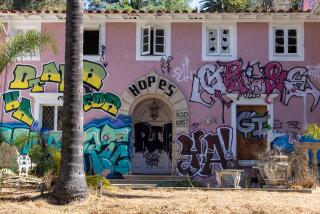DESIGN : Echoes of Picasso : Architectural firm’s House in the Hills borrows from the painter’s abstract masterpiece.
SHERMAN OAKS — In 1909, Pablo Picasso created a stir with his Cubist masterpiece “Houses on the Hill, Horta de Ebro.” The painting showed an angular network of gridlocked shapes, fused until space and mass were indistinguishable.
Today the master would smile if he saw the bold little house in the hills of Sherman Oaks that echoes his abstract creation.
Monochrome white, resembling a melted mass of building blocks, the house is a symphony of planes. Its contours are broken. Its shapes slide into one another. The gestalt is a constellation of whiteness, space and angles.
“The house evolved out of basic geometric forms,” says Jerry Sherman, 36, of Sherman + Ball, the two-man architectural firm based in Sherman Oaks that created the House in the Hills. “Our goal was to keep the look simple but surprising--like a large carved-away box.”
Sherman and partner Michael Ball, 39, built the home as a speculative venture; it was to be an antidote to the boxy Mediterranean shape that dominates Southern California’s terrain. But they finished its construction in September, 1990, at a time when Los Angeles’ real estate market was floundering.
“It was an expensive education,” admits Ball. “We learned about financing and construction--all the ups and downs--but because of it, I think we’re more aware of actual costs today. We can better help clients understand financing needs.”
Songwriters Bruce Gaitsch and Janey Clewer Gaitsch discovered the Sherman + Ball residence during a weekend house-hunting expedition.
“It was great-looking,” says Janey Clewer Gaitsch. “So we almost drove past it without stopping. We said to ourselves, ‘We probably can’t afford it.’ ” The flagging real estate market proved an ally to the composers. They purchased the house for $480,000 in 1991.
The house is entered through a monumental door reminiscent of the seemingly impregnable portals of modernist civic buildings. Immediately inside is a 30-foot-high foyer/tower whose playful square clerestory window faces out upon the house’s petite courtyard.
*
Rooms bleed into one another. Their boundaries are ambiguous. The first floor seems a consolidated expanse of living space, rather than a series of abrupt transitions from place to place. “That was the plan, to create flowing space and fill it with bright light so you can see all the way through the house from the front door to the back yard,” Ball says.
A sleek piano stands at the entrance to the high-ceilinged living room where Gaitsch and Clewer Gaitsch play music, compose, entertain guests or relax by a slate-framed fireplace.
Across from the living room is the 12-by-14-foot dining room that the couple have filled with graceful, unadorned furnishings.
Kitchen space is regally apportioned. Facing the kitchen is an all-purpose family room that leads to the house’s back yard. Tall bamboo shoots hedge the house’s south side to provide romantic privacy, while permitting light to amply permeate the home’s interior. “We’re happy here,” says Gaitsch, who has penned songs for Madonna and the pop group Chicago. “We had a lot of requirements for the house we’d eventually buy--we searched for about a year. I think this house just about met all of them.”
Susan Vaughn writes regularly about architecture for The Times.
More to Read
The biggest entertainment stories
Get our big stories about Hollywood, film, television, music, arts, culture and more right in your inbox as soon as they publish.
You may occasionally receive promotional content from the Los Angeles Times.










